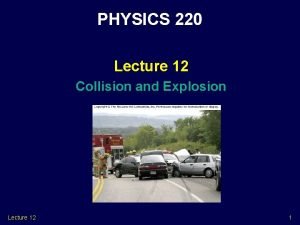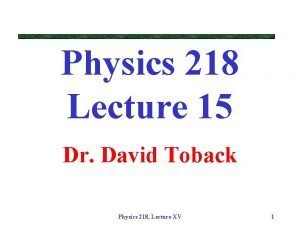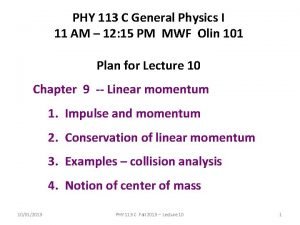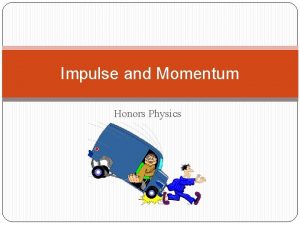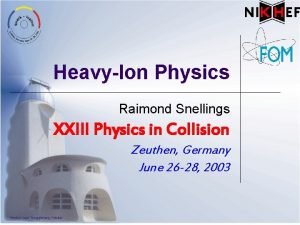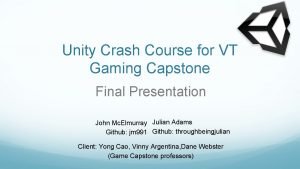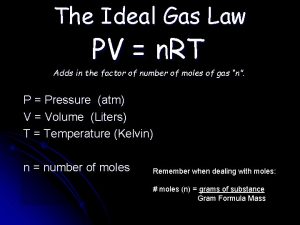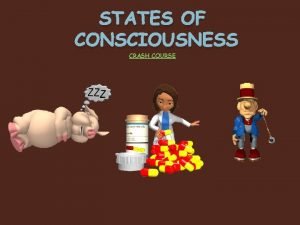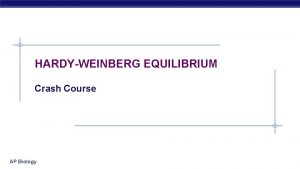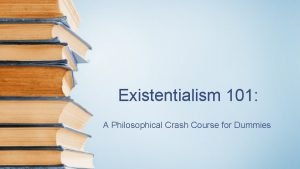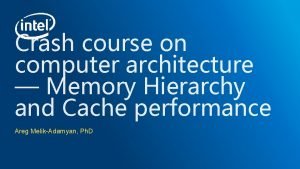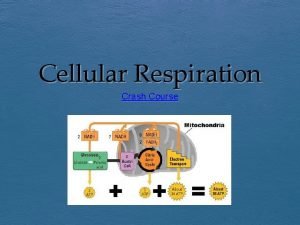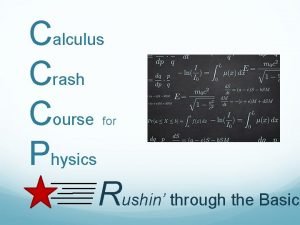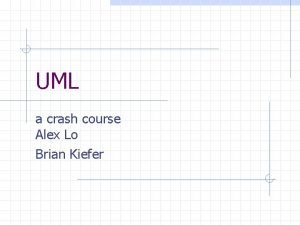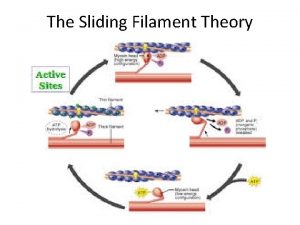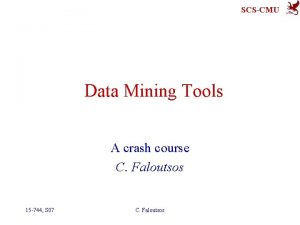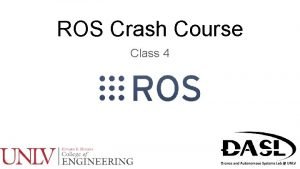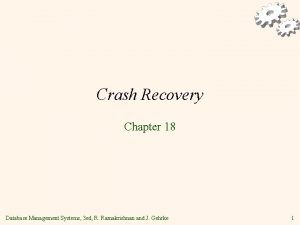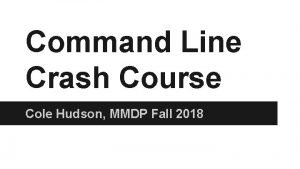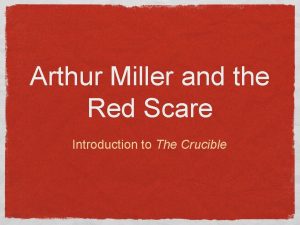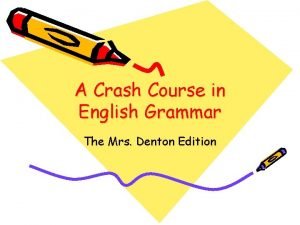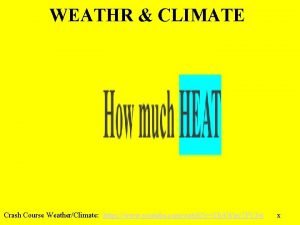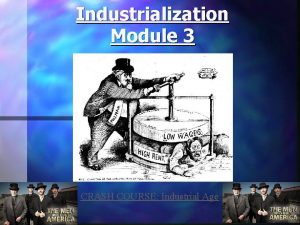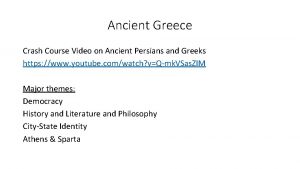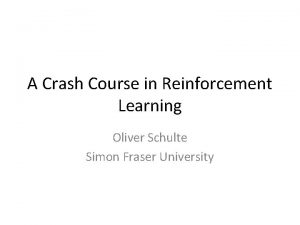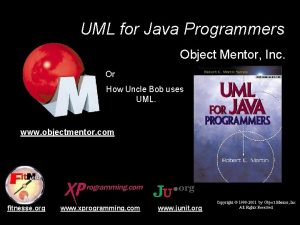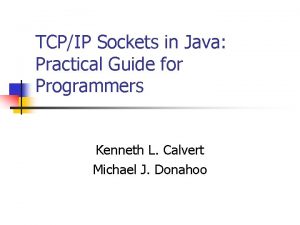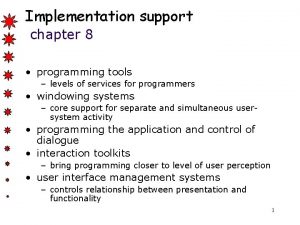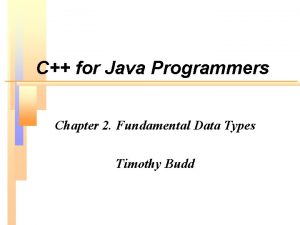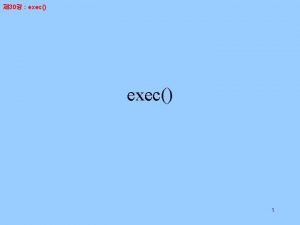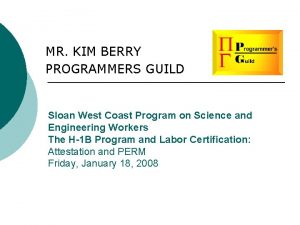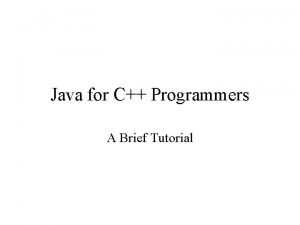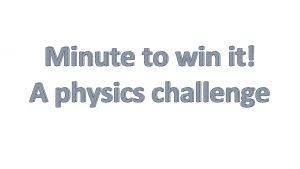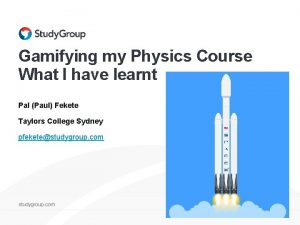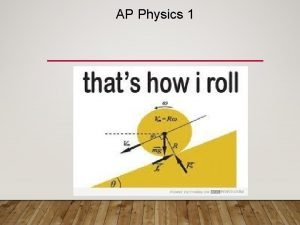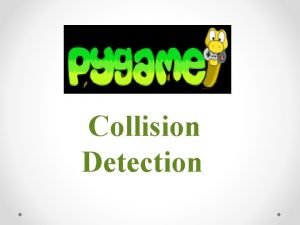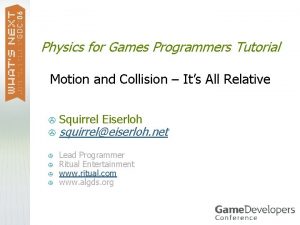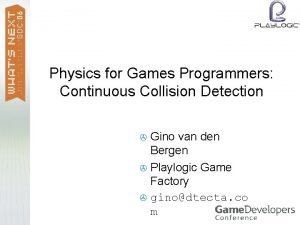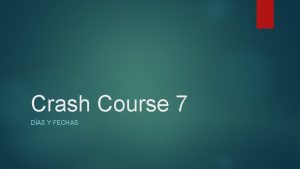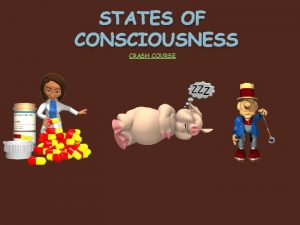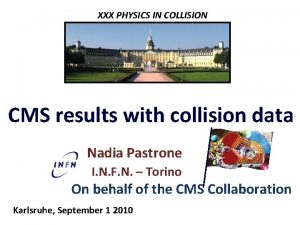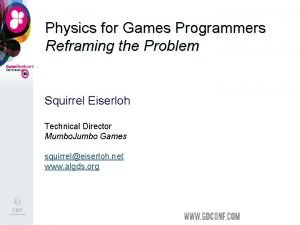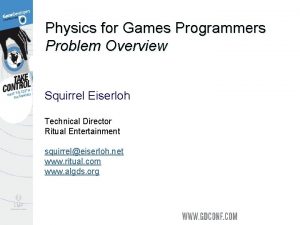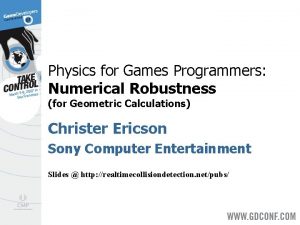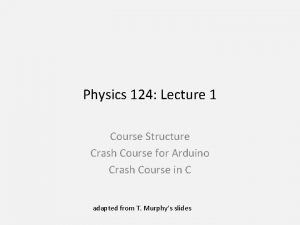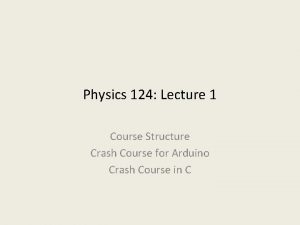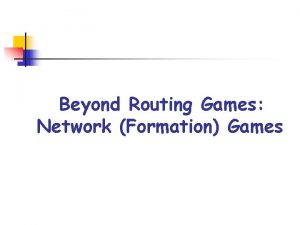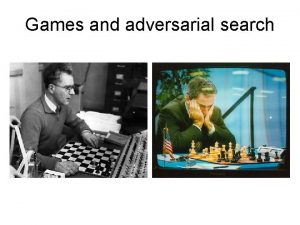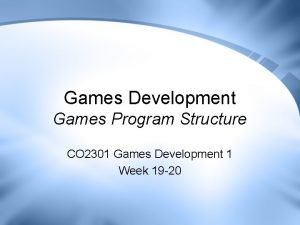Physics for Games Programmers Crash Course in Collision









































































![Sweep and Prune (3/3) When swapping “][“ to “[]”, the intervals start to overlap. Sweep and Prune (3/3) When swapping “][“ to “[]”, the intervals start to overlap.](https://slidetodoc.com/presentation_image/32a0b96fa91f8e8ae43f63d1649e4ad4/image-74.jpg)









- Slides: 83


Physics for Games Programmers: Crash Course in Collision Detection Gino van den Bergen gino@dtecta. com

Three Phases Broad phase: Determine all pairs of objects that potentially collide. > Mid phase: Determine potentially colliding primitives of a pair of objects. > Narrow phase: Determine contact between two primitive shapes. >

Overview > Narrow phase: Discrete: GJK algorithm > Continuous: GJK ray cast algorithm > Mid phase: AABB tree > Broad phase: > Discrete: Sweep & Prune > Continuous: Space-time Sweep & Prune >

Narrow Phase: GJK Algorithm An iterative method for computing the distance between convex objects. > First publication in 1988 by Gilbert, Johnson, and Keerthi. > Solves queries in configuration space. > Uses an implicit object representation. >

GJK Algorithm: Pros > Extremely versatile: Applicable to any combination of convex shape types. > Computes distances, common points, and separating axes. > Can be tailored for finding space-time collisions. > Allows a smooth trade-off between accuracy and speed. >

GJK Algorithm: Pros (cont'd) > Performs well: Exploits frame coherence. > Competitive with dedicated solutions for polytopes (Lin-Canny, V-Clip, SWIFT). > Despite its conceptual complexity, implementing GJK is not too difficult. > Small code size. >

GJK Algorithm: Cons > Difficult to grasp: Concepts from linear algebra and convex analysis (determinants, Minkowski addition), take some time to get comfortable with. > Maintaining a “geometric” mental image of the workings of the algorithm is challenging and not very helpful. >

GJK Algorithm: Cons (cont'd) > Suffers from numerical issues: Termination is governed by predicates that rely on tolerances. > Despite the use of tolerances, certain “hacks” are needed in order to guarantee termination in all cases. > Using 32 -bit floating-point numbers is doable but tricky. >

Configuration Space (recap) > The configuration space obstacle of objects A and B is the set of all vectors from a point of B to a point of A.

Configuration Space (cont’d) > A and B intersect: A – B contains origin. > Distance between A and B: length of shortest vector in A – B.

Translation > Translation of A and/or B results in a translation of A – B.

Rotation > Rotation of A and/or B changes the shape of A – B.

GJK Algorithm: Workings Approximate the point of the CSO closest to the origin > Generate a sequence of simplices inside the CSO, each simplex lying closer to the origin than its predecessor. > A simplex is a point, a line segment, a triangle, or a tetrahedron. >

GJK Algorithm: Workings (cont’d) Simplex vertices are computed using support mappings. (Definition follows) > Terminate as soon as the current simplex is close enough. > In case of an intersection, the simplex contains the origin. >

Support Mappings > A support mapping s. A of an object A maps vectors to points of A, such that Any point on this face may be returned as support point

Primitives

More Primitives

Affine Transformation > Shapes can be translated, rotated, and scaled. For T(x) = Bx + c, we have

Convex Hull > Convex hulls of arbitrary convex shapes are readily available.

Minkowski Sum > Shapes can be fattened by Minkowski addition.

Basic Steps (1/6) > Suppose we have a simplex inside the CSO…

Basic Steps (2/6) > …and the point v of the simplex closest to the origin.

Basic Steps (3/6) > Compute support point w = s. A-B(-v).

Basic Steps (4/6) > Add support point w to the current simplex.

Basic Steps (5/6) > Compute the closest point v’ of the new simplex.

Basic Steps (6/6) > Discard all vertices that do not contribute to v’.

Termination (1/3) > > > As upper bound for the squared distance we take the squared length of v. As lower bound we take v∙w, the signed distance of the supporting plane through w. Terminate a soon as where εrel is the tolerance for the relative error in the computed distance.

Termination (2/3) + 0

Termination (3/3) > > In case of a (near) contact, v will approximate zero, in which case previous termination condition is not likely to be met. As secondary termination condition we use where v is the current closest point, W is the set of vertices of the current simplex, and εtol is a tolerance based on the machine epsilon.

Separating Axes > > > If only an intersection test is needed then let GJK terminate as soon as the lower bound v∙w becomes positive. For a positive lower bound v∙w, the vector v is a separating axis. The origin and the CSO lie on different sides of the supporting plane, and thus, the CSO cannot contain the origin.

Separating Axes (cont'd) > The supporting plane through w separates the origin from the CSO. + 0

Separating Axes and Coherence > > > Separating axes can be cached and reused as initial v in future tests on the same object pairs. When the degree of frame coherence is high, the cached v is likely to be a separating axis in the new frame as well. An incremental version of GJK takes roughly one iteration per frame for smoothly moving objects.

Barycentric Coordinates > A point x of a simplex can be expressed as a convex combination of the vertices yi > The parameters λi are better known as barycentric coordinates of x with respect to yi.

Computing Contact Data > > For interpenetrating objects GJK returns a simplex W (usually a tetrahedron) that contains the origin. GJK also returns the barycentric coordinates of the origin with respect to W. These are the λi for which

Common Point > Recall that simplex W is obtained from subtracting support points of A and B, thus > These support points form simplices contained by the respective objects. By storing these support points we can compute a common point >

Contact Normal > For doing physics we also need a contact normal. > For non-intersecting objects, the vector v at termination can be used as a contact normal. Compute the closest points using the barycentric coordinates of v, similar to common-point computation. >

Contact Normal (cont’d) > > The closest points form proper contact data as long as the objects do not interpenetrate. However, keeping the objects from interpenetrating can be problematic.

Penetration Depth > > For interpenetrating objects we use the penetration depth vector as contact normal. The penetration depth is the shortest distance over which one of the two objects needs to be translated in order to stop the objects from interpenetrating.

Penetration Depth (cont'd) > The vector v is the penetration depth vector. + 0

Expanding Polytope Algorithm Penetration depth cannot be computed using GJK. > For this you need a separate algorithm called Expanding Polytope Algorithm. > EPA relies also on support mappings and is applicable to the same family of convex shapes. >

Hybrid Approach Fatten objects by Minkowski addition of a tiny sphere. > The addition creates a smooth skin around the objects (bones). > If only the skins are overlapping, use the closest points of the bones to find the contact data. >

Hybrid Approach (cont’d) As soon as the bones start overlapping use EPA on the fattened objects to find the penetration depth vector. > EPA is used only for emergencies. > Bonus: fattened objects have rounded edges, so normals behave less jumpy over time. (No jitter!) >

Contact Manifolds (1/4) > > > GJK and EPA return a pair of simplices at termination. These lie in the contact plane but do not form the complete contact manifold. Not having the complete contact manifold will result in jitter.

Contact Manifolds (2/4) > Create contact manifold by performing a local search on the objects: Slightly perturb the normal by adding a tiny vector. > Add the support point for the perturbed normal if it is a new vertex. > Perturb in some structured fashion, e. g. N, NE, E, S, SW, W, NW. >

Contact Manifolds (3/4) > > The added support points for the perturbed vectors result in a complete contact manifold. The perturbation needs to be only slightly larger that the numerical noise in computed normal.

Contact Manifolds (4/4) Manifolds obtained from convex objects are points, line segments, and convex polygons. > The intersection of the manifolds, again a point, a line segment, or a convex polygon, forms the contact manifold. >

Shape Casting > > Find the earliest time two translated objects come in contact. Boils down to performing a ray cast in the objects’ configuration space. For objects A and B being translated over respectively vectors s and t, we perform a ray cast along the vector r = t – s onto A – B. The earliest time of contact is

Normals > A normal at the hit point of the ray is normal to the contact plane.

Ray Clipping

GJK Ray Cast Do a standard GJK iteration, and use the support planes as clipping planes. > Each time the ray is clipped, the origin is “shifted” to λr, … > …and the current simplex is set to the lastfound support point. > The vector -v that corresponds to the latest clipping plane is the normal at the hit point. >

GJK Ray Cast (cont'd) The origin advances to the new lower bound. The vector -v is the latest normal.

Accuracy vs. Performance Accuracy can be traded for performance by tweaking the error tolerance εtol. > A greater tolerance results in fewer iterations but less accurate hit points and normals. >

Accuracy vs. Performance > εtol = 10 -7, avg. time: 3. 65 μs @ 2. 6 GHz

Accuracy vs. Performance > εtol = 10 -6, avg. time: 2. 80 μs @ 2. 6 GHz

Accuracy vs. Performance > εtol = 10 -5, avg. time: 2. 03 μs @ 2. 6 GHz

Accuracy vs. Performance > εtol = 10 -4, avg. time: 1. 43 μs @ 2. 6 GHz

Accuracy vs. Performance > εtol = 10 -3, avg. time: 1. 02 μs @ 2. 6 GHz

Accuracy vs. Performance > εtol = 10 -2, avg. time: 0. 77 μs @ 2. 6 GHz

Accuracy vs. Performance > εtol = 10 -1, avg. time: 0. 62 μs @ 2. 6 GHz

Mid Phase: BV Trees Used for objects composed of lots of primitives, such as triangle meshes. > Aim is to quickly reject groups of primitives based on geometric locality. > ‘Capture’ locality by constructing a hierarchy of bounding volumes. >

Bounding Volumes Should fit the model as tightly as possible. > Overlap tests between volumes should be cheap. > Should use a small amount of memory. > Cost of computing the best-fit bounding volume should be low. >

Bounding Volumes > Good bounding volume types are: Spheres > Axis-aligned bounding boxes (AABBs) > Discrete-orientation polytopes (k-DOPs) > Oriented bounding boxes (OBBs) >

Bounding Volume Types Fit Test (ops) Memory (scalars) Best-fit Cost Sphere poor 11 4 high AABB fair ≤ 6 6 low k-DOP good ≤ 2 k 2 k medium excellent ≤ 200 15 high OBB

Why AABBs? Offer a fair trade-off between storage space and fit. > Overlap tests are fast. > Allow for fast construction and update of bounding volumes. > Storage requirements can be further reduced through compression. >

AABB Tree Construction 1. 2. 3. 4. 5. Compute the AABB of the set of primitives. Split the set using the plane that cuts the longest axis of the AABB in two equal halves. Primitives that straddle the plane are added to the dominant side. (AABBs of the two sets may overlap. ) Repeat from step 1 for the split sets. Continue until all sets contain one primitive.

Test Primitive vs. AABB Tree Compute the primitive’s AABB in the AABB tree’s local coordinate system. > Recursively visit all nodes whose AABBs overlap the primitive’s AABB. > Test each visited leaf’s primitive against the query primtive. >

Test Oriented AABB Trees Simultaneously descend in both trees. > Requires an oriented-box test such as the SAT (lite). > Always unfold the largest of the current two AABBs. > If both sub-trees are leaves, perform a primitive-primitive test. >

Updating AABB Trees AABB trees can be updated rather than recomputed for deformable meshes. > First recompute the AABBs of the leaves. > Work your way back to the root: A parent’s box is the AABB of the children’s boxes. >

Broad Phase: Sweep & Prune Find pairs of objects whose axis-aligned bounding boxes overlap. > We need something better than the O(n 2) testall-pairs approach. > Exploit temporal coherence: the configuration of objects does not change a lot per frame. >

Sweep and Prune (1/3) For each world axis, maintain a sorted list of interval endpoints. > Maintain also the set of overlapping box pairs. > When a box moves, locally re-sort the lists by comparing and (if necessary) swapping the box endpoints with adjacent endpoints. >

Sweep and Prune (2/3) Re-order endpoints of moving objects. A B

Sweep and Prune (2/3) Re-order endpoints of moving objects. A B
![Sweep and Prune 33 When swapping to the intervals start to overlap Sweep and Prune (3/3) When swapping “][“ to “[]”, the intervals start to overlap.](https://slidetodoc.com/presentation_image/32a0b96fa91f8e8ae43f63d1649e4ad4/image-74.jpg)
Sweep and Prune (3/3) When swapping “][“ to “[]”, the intervals start to overlap. > When swapping “[]“ to “][”, the intervals cease to overlap. > If the intervals on the other axes overlap, then the box pair starts or ceases to overlap. >

Adding Time: Encapsulation Enlarge AABBs of moving objects, such that they encapsulate the swept AABBs. > Creates false positives: Encapsulating AABBs overlap where in space-time, the actual AABBs do not. >

Adding Time: Encapsulation (cont'd) Encapsulation results in false positives. A B

Adding Time: Queued Swaps > > Perform endpoint swaps in the proper order. Calculate swap times and prioritize swaps on earliest time. After each swap, re-evaluate swaps with new neighbors. Needs a priority queue that offers a decrease-key operation (as in Dijkstra’s algorithm or A*).

Adding Time: Queued Swaps (cont'd) Swap endpoints in the proper order. A B

Adding Time: Queued Swaps (cont'd) Swap endpoints in the proper order. A B

Adding Time: Queued Swaps (cont'd) Swap endpoints in the proper order. A B

Motion Coherence > > > Space-time Sweep and Prune is often faster than the original version when many objects are moving in the same direction. Among a group of objects all having the same velocity vector not a single endpoint swap needs to be done. Ideal for particle and fluid simulations.

References > > > Thomas H. Cormen et al. Introduction to Algorithms, Second Edition. MIT Press, 2001. E. G. Gilbert, D. W. Johnson, and S. S. Keerthi. A fast procedure for computing the distance between complex objects in three-dimensional space. IEEE Journal of Robotics and Automation, 4(2): 192 -203, 1988. Gino van den Bergen. Collision Detection in Interactive 3 D Environments. Morgan Kaufmann Publishers, 2004.

Thank You! > For papers and other information, check: http: //www. dtecta. com
 A freight train is being assembled in a switching yard
A freight train is being assembled in a switching yard Collision physics
Collision physics Fall 2013
Fall 2013 Relationship between momentum and impulse
Relationship between momentum and impulse Collision physics
Collision physics Crash course molecular biology
Crash course molecular biology Unity over the shoulder camera
Unity over the shoulder camera Gas laws crash course
Gas laws crash course Crusades crash course
Crusades crash course Cold war crash course
Cold war crash course Crash course psychology consciousness
Crash course psychology consciousness Social psychology crash course
Social psychology crash course Movable muscle
Movable muscle React traversy media
React traversy media Project management crash course
Project management crash course Meth eth
Meth eth Hardy weinberg crash course
Hardy weinberg crash course Existential definition for dummies
Existential definition for dummies Computer architecture crash course
Computer architecture crash course Crash course heart
Crash course heart Aerobic respiration crash course
Aerobic respiration crash course Crash course calculus
Crash course calculus Aspe 3856
Aspe 3856 Robotics crash course
Robotics crash course Crash course wwi
Crash course wwi Uml crash course
Uml crash course Crash course sliding filament theory
Crash course sliding filament theory Data mining crash course
Data mining crash course Schizophrenia crash course
Schizophrenia crash course Ros crash course
Ros crash course Cognitive psychology crash course
Cognitive psychology crash course Physical chemistry crash course
Physical chemistry crash course Crash course personality
Crash course personality Database management system crash course
Database management system crash course Drupal crash course
Drupal crash course The command line crash course
The command line crash course The crucible crash course
The crucible crash course Crash course english grammar
Crash course english grammar Weathevr
Weathevr Weather vs climate crash course
Weather vs climate crash course Crash course protestant reformation
Crash course protestant reformation Coccyx meaning
Coccyx meaning Industrialization crash course
Industrialization crash course Phylogenetic tree grade 11
Phylogenetic tree grade 11 Crash course harlem renaissance
Crash course harlem renaissance Ancient greece crash course
Ancient greece crash course Ap language and composition crash course
Ap language and composition crash course Fast twitch and slow twitch muscles
Fast twitch and slow twitch muscles Crash course test anxiety
Crash course test anxiety Reinforcement learning crash course
Reinforcement learning crash course Object mentor
Object mentor Tcp/ip sockets in java: practical guide for programmers
Tcp/ip sockets in java: practical guide for programmers Programmers use backdoors to debug and test programs.
Programmers use backdoors to debug and test programs. It has levels of services for programmers
It has levels of services for programmers Is bool a fundamental data type in c++
Is bool a fundamental data type in c++ Linux programmer's manual
Linux programmer's manual Programmers guild
Programmers guild Java for c programmers
Java for c programmers How did rue die hunger games
How did rue die hunger games Types of games indoor and outdoor
Types of games indoor and outdoor Stream minute to win it
Stream minute to win it T junction in english bond
T junction in english bond Course title and course number
Course title and course number Course interne course externe
Course interne course externe Game physics course
Game physics course Physics a first course
Physics a first course Ap physics 1 course description
Ap physics 1 course description Modern physics vs classical physics
Modern physics vs classical physics University physics with modern physics fifteenth edition
University physics with modern physics fifteenth edition Ia topics for physics
Ia topics for physics Fspos vägledning för kontinuitetshantering
Fspos vägledning för kontinuitetshantering Novell typiska drag
Novell typiska drag Tack för att ni lyssnade bild
Tack för att ni lyssnade bild Returpilarna
Returpilarna Varför kallas perioden 1918-1939 för mellankrigstiden
Varför kallas perioden 1918-1939 för mellankrigstiden En lathund för arbete med kontinuitetshantering
En lathund för arbete med kontinuitetshantering Personalliggare bygg undantag
Personalliggare bygg undantag Personlig tidbok
Personlig tidbok A gastrica
A gastrica Vad är densitet
Vad är densitet Datorkunskap för nybörjare
Datorkunskap för nybörjare Stig kerman
Stig kerman Debattartikel mall
Debattartikel mall Delegerande ledarskap
Delegerande ledarskap
